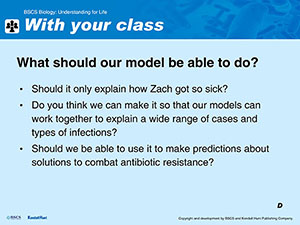CHAPTER 3 • LESSON 15 • SYNTHESIZE
What explains the increasing incidence of antibiotic-resistant infections?
PURPOSE | Connect key science ideas and build consensus around explaining an aspect of the Anchor phenomenon or problem.

TIME
Two 50-minute class periods
PREVIOUS LESSON | We designed a simulation to model how the proportions of existing traits within a population of bacteria can change over generations, leading to antibiotic resistance. This left us wondering: Why is this happening more often?
THIS LESSON | We develop a model to figure out how all the ideas from this chapter connect with each other to explain the increasing incidence of antibiotic-resistant infections. This leaves us wondering: What can we do to contribute to antibiotic stewardship?
NEXT LESSON | In the Culminating Task, we will investigate schoolmates’ perceptions as well as medical professionals’ needs and ideas. We will use this information to help us create a checklist for ourselves and our peers to use to improve the doctor-patient partnership for better antibiotic stewardship.
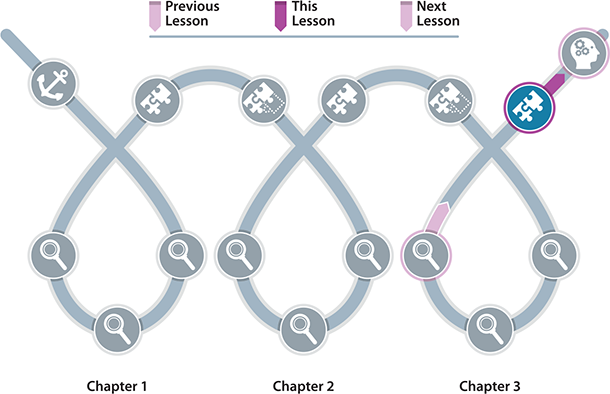
 LESSON LEARNING GOALS
LESSON LEARNING GOALS
Develop and revise a Class Consensus Model to explain how increased use of antibiotics can result in increased prevalence of antibiotic-resistant bacteria and how stewardship practices can result in decreased prevalence of antibiotic-resistant bacteria.
Lesson question
What explains the increasing incidence of antibiotic-resistant infections?
What students figure out
Our models show us that proper use of antibiotics would decrease the rate of development of resistant populations of bacteria.
With fewer resistant strains out in the environment, Zach would have been less likely to get his infection.
What we are not expecting
Where we are not going yet
We are not yet connecting our learning to communication between patients and medical professionals; we will do this in the next lesson.
We are not yet exploring genetics or sources of variation, including mutation, sexual reproduction, and meiosis; we investigate sources of variation in unit 2, and then connect our ideas about natural selection, genetics, and evolution to apply them to questions about biodiversity in unit 4.
Boundaries
We do not expect students to learn about or understand other mechanisms of evolution, including genetic drift, gene flow through migration, and co-evolution.
We do not expect students to do any allele frequency calculations.
Relevant common student ideas
Evolution happens when individual organisms acclimate or “get used to” new conditions gradually. (While individual organisms are sometimes able to adjust or acclimate to new conditions, evolution by natural selection refers to adaptation that occurs over generations, when individuals with advantageous traits reproduce more often and the trait becomes more prevalent in the population.)
Changes in a population occur through a gradual change in all members of a population, not from the survival of a few individuals that preferentially reproduce. (Gradual change in individuals, in response to their environment, cannot be passed to the next generation.)
Individual organisms can deliberately develop new heritable traits because they need them for survival. (Individual organisms do not have the power to “will” new traits into existence.)
The “fittest” in “survival of the fittest” means “the most physically fit.” (Darwinian fitness refers to a measure of the total [or relative] reproductive output of an organism with a particular genotype. It does not refer to physical condition, strength, or stamina.)
Survival of individuals with a trait variant (regardless of reproduction) leads that trait variant to become more prevalent via natural selection. (Survival is only important evolutionarily insofar as it affects the number of offspring produced.)
Mutations occur in response to a need based on a changing environment. (Mutation is random with respect to need. Occasionally when a mutation happens to be beneficial, natural selection causes it to increase in prevalence in the population. But mutation itself does not occur because it would be beneficial.)
Natural selection is an event, rather than a process. (Natural selection is a process; it occurs continually within populations. It does not have a beginning, end, or goal.)
Natural selection is “all or nothing,” rather than probabilistic. (Not all unfit individuals die, and not all fit individuals survive. Fitter individuals are simply more likely to survive. Even a small difference in this likelihood can cause traits of fitter individuals to increase in frequency in the population over time.)
Key literacy and sensemaking strategies
Scientists Circle
Students form a Scientists Circle again; students should recall that this routine is helpful any time we need to collaborate to make sense as a whole class.
Communicating in Scientific Ways
To aid them with these discussion-based activities, students will also rely on the Communicating in Scientific Ways talk stems.
Gotta-Have-It Checklist
Students will update their Gotta-Have-It Checklist (from chapter 2) in this lesson to help them plan for revising their Class Consensus Model.
Class Consensus Model
This is the third time students will collaboratively construct a Class Consensus Model to explain part of our unit Driving Question; push students to do more of the heavy lifting in deciding how to draw the revised model.
-
Students use the Argument Tool to support an explanation for how and why using antibiotics when we don’t need them can contribute to the increasing prevalence of antibiotic-resistant infections.
ASSESSMENT
Formative assessment: “I need something because I’m sick”
This task is an opportunity for students to use what they learned to explain how it applies to policies of antibiotic stewardship. See Assessment callout for more detail on what to look for.
Students’ completed Argument Tools are a good opportunity for formative assessment. To assess content understanding, look for student writing that includes the following key ideas:
Populations of bacteria are made up of individuals with variation.
Some of those variations are heritable.
Some of those variations confer protection in the presence of antibiotics.
As they are exposed to antibiotics, more individuals with helpful variations survive.
As these individuals reproduce and the ones that do not survive do not reproduce, the proportion of the population having the helpful (resistant) trait increases over time.
The more we use antibiotics, the more chances there are for populations to become resistant.
Look for student writing that:
Integrates evidence with science ideas, rather than treating them as separate lists
Only includes relevant evidence, not lists of everything we did in class
Communicates clearly to others, rather than assuming “mind reading” (e.g., “my evidence is that thing we did on Tuesday”)
Summative assessment: Unit Assessment
After completing this Synthesize Lesson, students should be prepared to take the Unit Assessment that follows. This scenario-based assessment is appropriate for grading.
 SYNTHESIZE LESSON SNAPSHOT
SYNTHESIZE LESSON SNAPSHOT
Lesson 15: What explains the increasing incidence of antibiotic-resistant infections?
BIG IDEA | The incidence of antibiotic-resistant infections is increasing because natural selection leads to increased antibiotic resistance with increased use of antibiotics; we must use antibiotics sparingly and responsibly.
Routine |
Part |
Time |
Summary |
Slide |
Materials |
|
1 |
8 min |
Reflect on questions from the Driving Question Board. Students review the questions on the DQB, identify some that we might have answered, and consider if we know enough now to explain more about how and why Zach’s infection was “antibiotic resistant.” Purpose: to recognize our learning and to motivate the need to link our ideas together to come up with a way to explain how the bacteria that infected Zach came to be antibiotic-resistant. |
A–B |
Driving Question Board |
|
2 |
12 min |
Decide what our model needs to do. Drawing ideas from their Model Tracker, and their original Class Consensus Model from chapter 2, students discuss how they could revise or update this model for it to be able to explain what happens in the body during an infection. They use these ideas to build on their previous Gotta-Have-It Checklist that includes key components and interactions. Purpose: to organize our thinking and lift up all the components and interactions necessary to prepare for collaborating to revise our Class Consensus Model. |
C–F |
Science notebooks Gotta-Have-It Checklist (from Lesson 10) Class Consensus Model (from Lesson 10) |
3 |
30 min |
Construct a Class Consensus Model. Students work as a class to revise and build on their Class Consensus Model to explain how, through a process called natural selection, differences in heritable traits between individual bacteria within a population can provide an advantage when exposed to antibiotics, and how the more antibiotics are applied, the more the proportion of the population having these antibiotic-resistant traits will increase. Purpose: to reach consensus on a model that explains how some populations of bacteria that can infect us have become antibiotic-resistant. |
E |
Science notebooks Gotta-Have-It Checklist Class Consensus Model |
|
Suggested class period break End of Day 1 |
|||||
|
4 |
15 min |
Reflect on precision in language and prior Antibiotic Use Survey results. Students reflect on how being precise with language helped them understand natural selection and consider an issue with a common phrase: “survival of the fittest.” They revisit the Antibiotic Use Survey they took at the start of the chapter and reflect on how their thinking has changed now that they know more about the causes of antibiotic-resistance. Purpose: to reflect on how our ideas change as we gather new evidence and how our understanding may influence our decisions as patients or caregivers. |
H–J |
Clearly Communicating Ideas chart Antibiotic Use Survey results |
|
5 |
15 min |
Support an explanation for why improper use of antibiotics contributes to resistance. Students work independently to use the Argument Tool to support an explanation for how and why unnecessary use of antibiotics contributes to the rise in antibiotic-resistant infections. Purpose: to apply our understanding to the societal issue and uncover the rationale for antibiotic stewardship. |
K–M |
Student Sheet 1.15.A: “But I need something because I’m sick” Science notebooks Class Consensus Model |
6 |
15 min |
Evaluate priorities for antibiotic stewardship. Students analyze potential solutions for antibiotic stewardship through the lenses of equity, bias, and perspectives. Purpose: to uncover the complexity of evaluating and enacting solutions to the societal issue. |
N |
Student Sheet 1.15.B: Priorities for Action Science notebooks Class Consensus Model |
|
|
7 |
5 min |
Motivate the need to put our learning into action in the Culminating Task. We return to Dr. Brad Spellberg’s quote that “it’s everyone’s fault” and consider how, given all the stakeholders involved (doctors, patients, researchers, drug companies, government), it might be best to start with ourselves or our peers as patients. Purpose: to motivate students to investigate and plan practical ways to help solve the societal issue in the Culminating Task. |
O |
Driving Question Board Class Consensus Model |
LESSON MATERIALS
Per student
Science notebooks
Sticky notes
Fine-point markers
Student Sheet 1.15.A: “But I need something because I’m sick”
Per class
Computer with projector
Chart paper
Chart markers (multiple colors)
Class Consensus Model (from Lesson 10)
Gotta-Have-It Checklist (from Lesson 10)
Class results from Antibiotic Use Survey (from Lesson 11)
Clearly Communicating Ideas chart (from Lesson 11)
Preparation
Make sure you have assessed overall class understanding using the Model Tracker Formative Assessment Tool (in Lesson 14) to ensure students have enough of the key ideas needed to be successful with this Synthesize Lesson.
Review the Class Consensus Models built at the ends of chapters 1 and 2. Note how these models build off the ideas and representations initially built, and how this could be approached now at the end of chapter 3.
Most of this lesson will be collaborative and discussion-based. Consider:
What are the key elements of the model or explanation you want the students to grapple with?
Try creating an explanatory model for this phenomenon for yourself.
Clear a space in your classroom for displaying chart papers to post and update the Gotta-Have-It Checklist and Class Consensus Model.
Make copies of student sheets.
ADDITIONAL CONTENT BACKGROUND FOR THE TEACHER
According to the CDC, “antibiotic stewardship is the effort to measure and improve how antibiotics are prescribed by clinicians and used by patients. Improving antibiotic prescribing and use is critical to effectively treat infections, protect patients from harms caused by unnecessary antibiotic use, and combat antibiotic resistance.”
In this lesson, students apply their understanding of how a resistant population of bacteria could develop to reason about why being careful about the use of antibiotics is necessary. They also explore broader systemic issues such as the use of antibiotics in agriculture, and the economics of funding research and development of new antibiotics. While students should gain an increasing appreciation for the complexity of this issue, they should also feel empowered to make a contribution at the individual level in the next lesson.
 NAVIGATE
NAVIGATE
PURPOSE | To maintain coherence and continuity
Students reflect on questions they have answered from the Driving Question Board (DQB).
As students enter, have Slide A displayed. Have students open their science notebooks to a fresh page and have them write the date and “Lesson 15.” On the next page, ask students to jot down some questions from the DQB that they believe we now have the answers to (if they are having trouble getting started, invite them to visit the DQB, and jot down which of the questions we have answered so far). Ask them to also record any questions that we are starting to answer, but haven’t completely figured out yet.
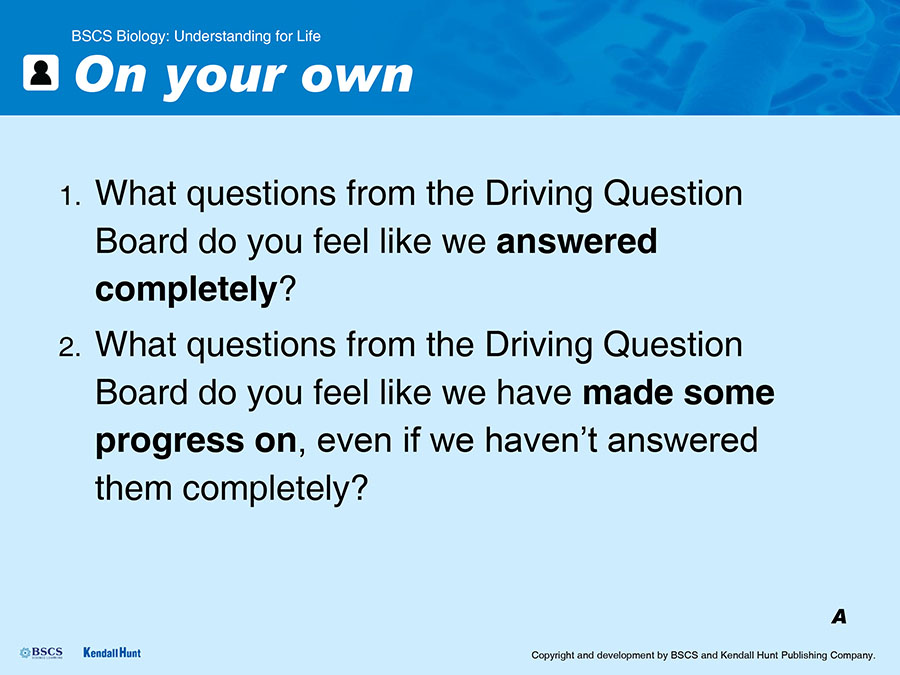
Students share some of the questions they can answer.
Display Slide B. Ask students to share their ideas with their elbow partner, and to also discuss what we did in class to help us answer that question. Bring the class back together to share ideas with the whole group.
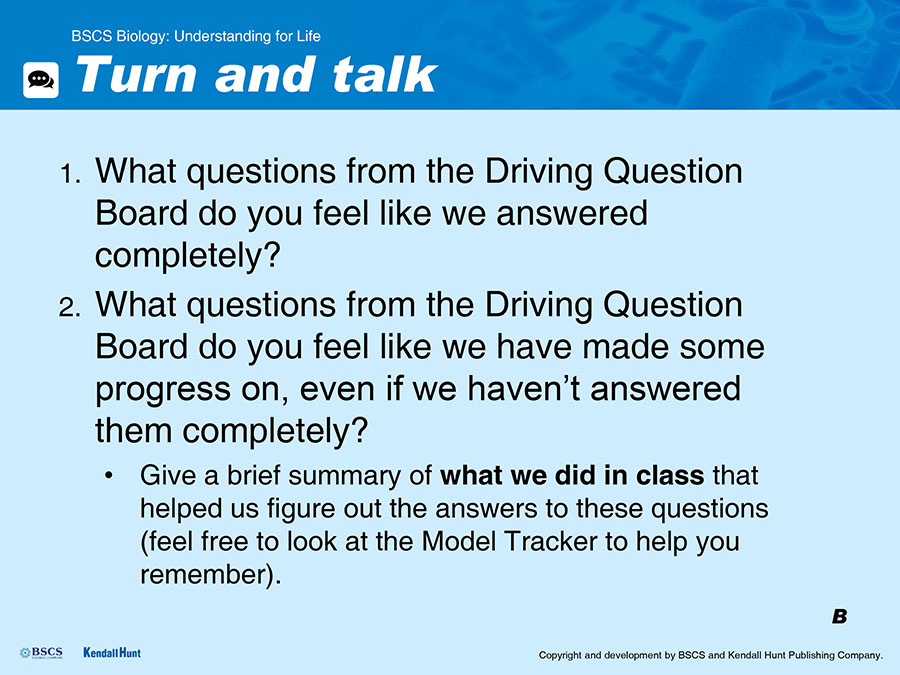
| Suggested prompts | Listen for student responses such as |
|---|---|
Which of the questions on the DQB do you feel like we answered, or started to answer? And what did we do in class that helped us figure out the answers to those questions? |
|
Students consider how building a model at the end of chapters 1 and 2 was useful.
Facilitate a discussion to motivate the need to revise our last Class Consensus Model (from the end of chapter 2) of what we’ve figured out now to see if that helps us explain more about Zach’s case.
| Suggested prompts | Listen for student responses such as |
|---|---|
At the ends of chapters 1 and 2, we figured out a lot about how bacteria can cause infections. How did building and using the model help move our thinking forward? |
We answered many of our questions from the DQB. But we also realized our model didn’t fully explain why doctors are worried about an increase in antibiotic-resistant infections; it helped point us in a direction to figure out what we still needed to know. |
Have we similarly figured out a lot about what is causing the increase in antibiotic-resistant infections that doctors are concerned about? |
Yes, we’ve figured out a lot, and we could go back to our Consensus Model and update it. |
Students capture the new question we can revise our model to include.
Have students think about whether what we learned so far helps us explain any new aspects of what happened to Zach and others—and more generally, What explains the increasing incidence of antibiotic-resistant infections? Pause to have students record this lesson question (or similar, using students’ own words) on the page they started for Lesson 15 in their science notebooks.
 CONNECT IDEAS TO MAKE SENSE
CONNECT IDEAS TO MAKE SENSE
PURPOSE | To make connections between ideas and evidence
Students gather in a Scientists Circle to make a collective plan for building our model to explain Zach’s case and related cases.
Display Slide C. Ask students to gather with their science notebooks in a Scientists Circle around a common area. This area should allow all students visual access to the DQB, chapter 2 Gotta-Have-It Checklist, and chapter 2 Class Consensus Model.
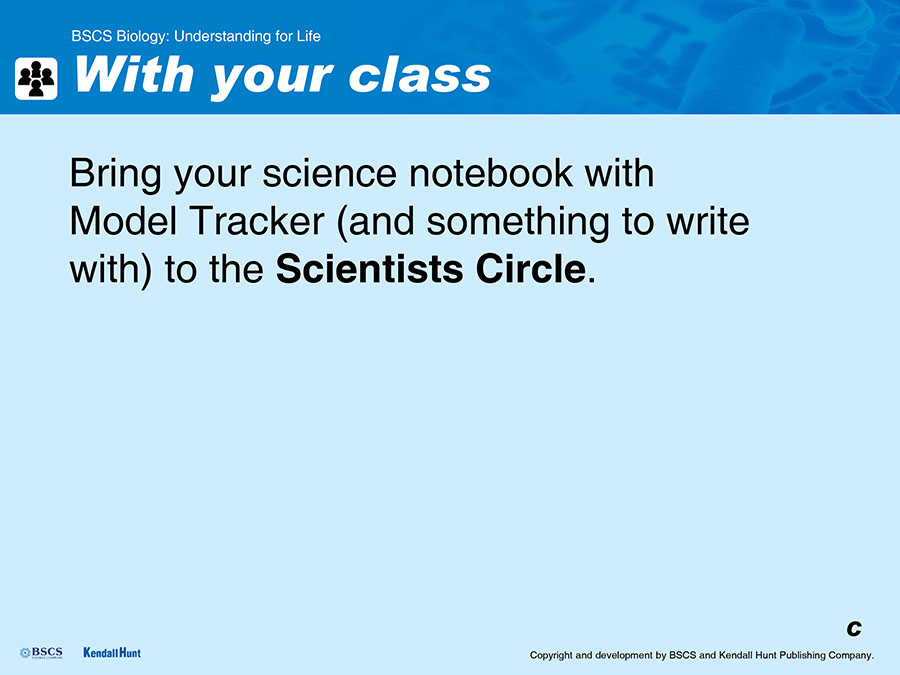
If they haven’t already, have students open their science notebooks to the page where they attached the Communicating in Scientific Ways steps. Point out the “Let your ideas change and grow” section of Communicating in Scientific Ways and suggest to students to consider using these stems as they explain any new understandings about what “resistance” means.
Show Slide D. Allow students to reflect on what our model should be able to do. How can we revise our existing Class Consensus Model to include what we know now?

| Suggested prompts | Listen for student responses such as |
|---|---|
What exactly do we need our model to do? |
We want to explain how Zach got so sick with an antibiotic-resistant infection, but we also want our model to explain more than just one case. |
Are the ideas we are building happening in a similar set of systems to those we created in our current consensus model? Could we still use the “systems” as a starting place to think about revision? |
|
Students use their Model Trackers to highlight ideas that we should include in our model.
Display Slide E. Give students individual time to highlight ideas they think are important to include in our explanatory model.
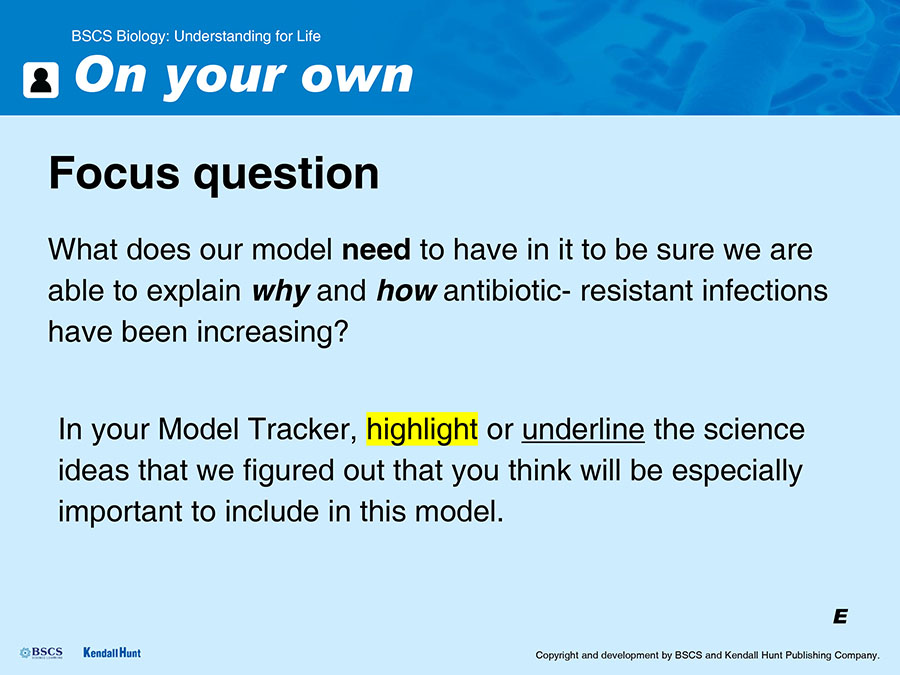
Suggested framing: “Given the extremely complicated pathways we learned about to understand these ideas, what would our model need to have in it to be sure we are able to explain why and how antibiotic-resistant infections have been increasing? Take some time on your own like we did last time to highlight the science ideas we figured out that you think will be really important to include in this model.”
After students finish annotating their Model Trackers, show Slide F and give them some time to work with a partner to compare ideas and create a separate list of things they think must be represented in the final model.
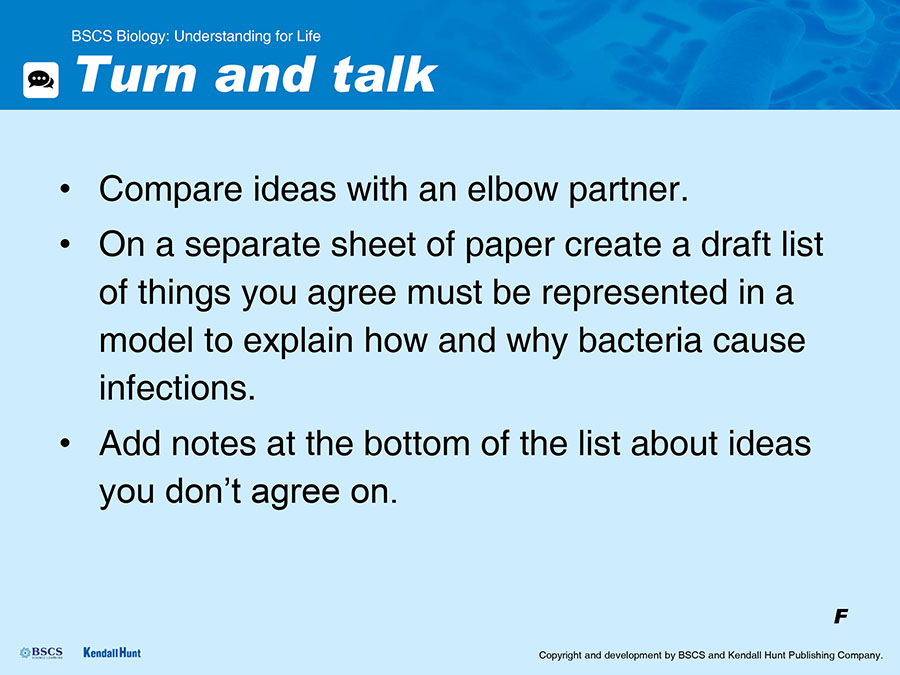
The class updates the Gotta-Have-It Checklist for updating the Class Consensus Model.
Have the class consider: How can we update our existing Gotta-Have-It Checklist to have everything we need to explain: “What explains the increasing incidence of antibiotic-resistant infections?”
Draw attention to the existing Gotta-Have-It Checklist from chapter 2 and ask if there is anything from that list that needs to be modified, or would it be OK to just add to that list?
Gotta-Have-It Checklist
| Components | Interactions |
|
|
Sample updated Gotta-Have-It Checklist.
Prompt students to identify the components from their Model Trackers to start, then work collectively to build sentences that show how the components interact.
Take ideas from all students and write them on large chart paper until all ideas are recorded. If students give partial ideas, use clarifying questions to push them for more complete ideas.
Once most of the ideas are on the list, push students to think about how complex this model could get. Given how long the list is getting, suggest that we might want to circle, underline, or highlight the ideas we want to show in the version of the model that focuses on what we figured out in chapter 3. Remind students that we, of course, will hang onto our chapter 1 and 2 models for reference as well.
Developing the Crosscutting Concepts: Systems and System Models
Students continue using separate lists of components and interactions as an organizing framework for developing a system model.
Students discuss initial ideas for updating the Class Consensus Model.
Organize students into pairs and encourage them to discuss ideas for how they could add to or modify the existing Class Consensus Model to accommodate all the new things on the Gotta-Have-It Checklist. As they discuss, one or both members of each pair should sketch some initial ideas in their science notebooks. Circulate as students work to get a sense of which student ideas might be beneficial to lift up in the whole-class discussion
The class discusses options for directions to take the Class Consensus Model.
Invite pairs to share out their ideas. Make blank chart paper available for them to show their ideas to the class in addition to describing them. Encourage students to build on any ideas that have a lot of agreement across the class. Once there is consensus around a fruitful direction, you may start a fresh piece of chart paper to draw (or have a student volunteer draw) the basis for the revised Class Consensus Model.
Continue to facilitate the discussion until the class is satisfied that they have captured everything highlighted on the Gotta-Have-It Checklist.
Developing the Practices: Developing and Using Models
Students gain independence with this task now that they have worked together toward a similar goal in chapters 1 and 2. The teacher can take more of a “back seat” as students drive the direction for the model.
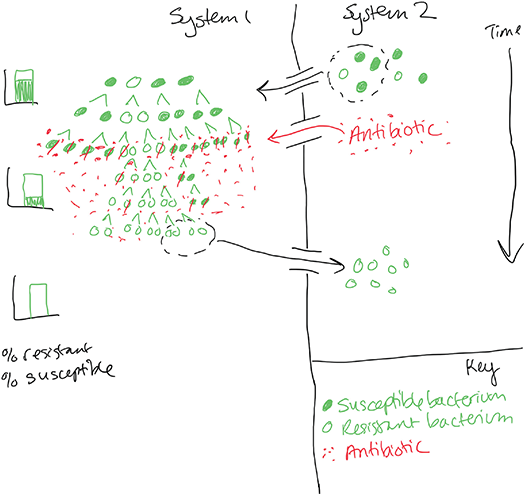
Sample completed revised Class Consensus Model
The class reflects on whether we met the goal of explaining how and why antibiotic-resistant infections have been increasing.
Show Slide G. Challenge the class to come up with an oral explanation by only using the model to see if it makes sense, or if there are still some gaps we can fill with information from the Gotta-Have-It Checklist. Give students time to share ideas with an elbow partner before returning to discuss and “tell the story” as a whole group.
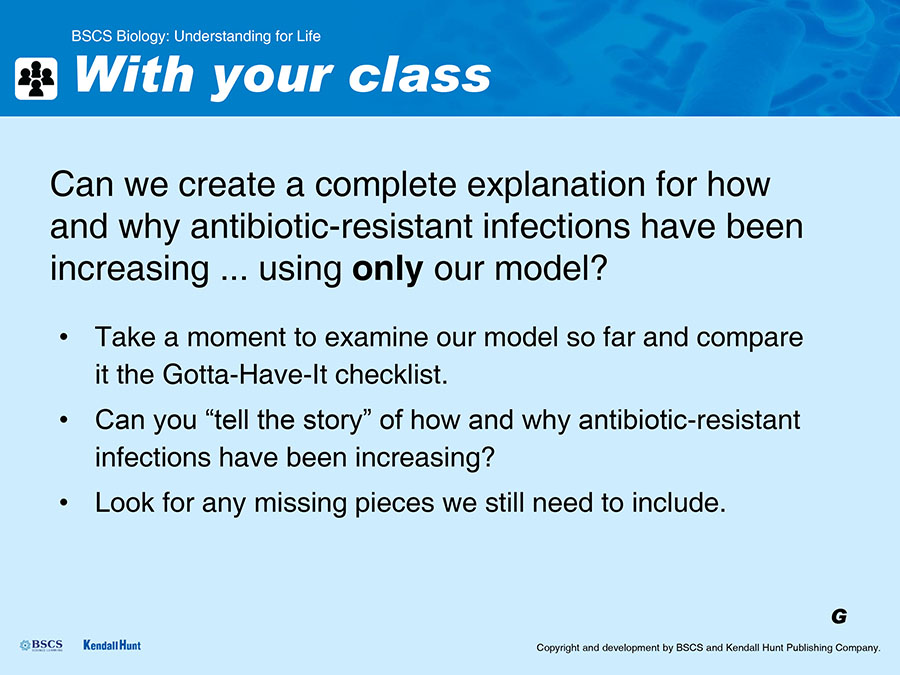

SUGGESTED CLASS PERIOD BREAK
End of Day 1
 REFLECT AND CONNECT
REFLECT AND CONNECT
PURPOSE | To reflect on our learning progress and process
Students reflect on how being precise with language helped us understand the process of natural selection.
Have students look back at their Clearly Communicating Ideas chart. Have them quietly reflect on all the words we added, and how tricky it can be to know what someone really means when discussing a complex process that occurs at both a cellular and a population level.
The class considers the famous phrase “survival of the fittest.”
Display Slide H. Ask students if they have heard the term “survival of the fittest” and if they feel like they have a good understanding of what that means.
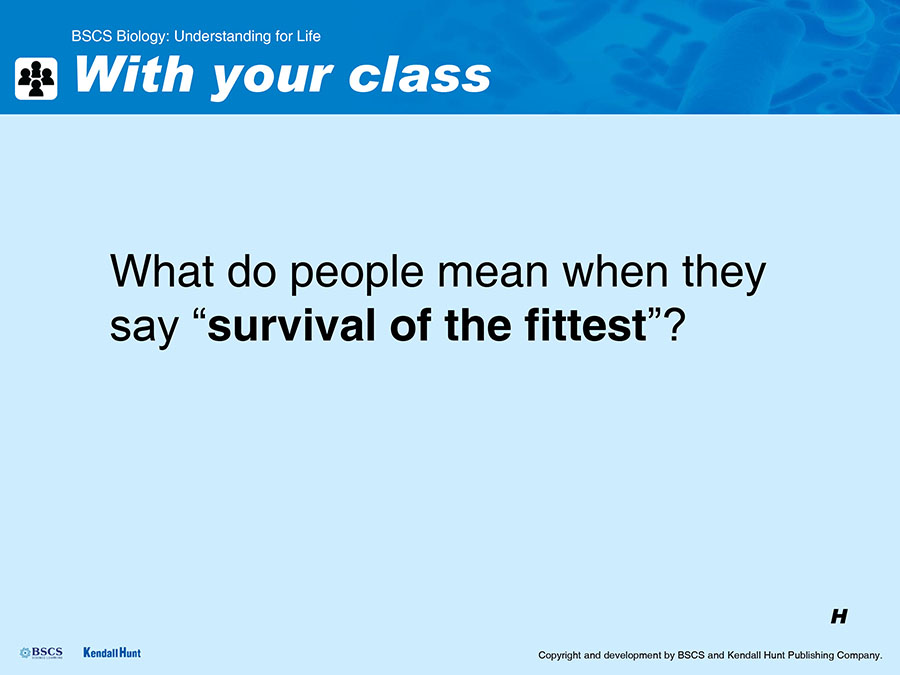
Facilitate a discussion to lift up the idea that the phrase, while commonly used, is actually misleading, because really reproduction is the most important idea for how populations change over time. The suggested prompts use squirrels because they are a common animal in many landscapes, so most students will be familiar with them and may have noticed some of their behavior. However, feel free to use whatever example you think your class will connect with.
Display Slide I. Set up the scenario: “Let’s consider two organisms, in this case squirrels. One squirrel (squirrel 1) is very cautious, he sneaks down from his tree only when he’s sure no other organisms are around. He’s managed to evade predators and he’s still alive. He is 17 years old and that is extraordinarily old for a squirrel in the wild. Our other squirrel (squirrel 2) is not nearly as cautious; he is up and down the tree many times a day and I often see him chasing other squirrels around. I’ve watched this squirrel for the past 3 years because he is entertaining. Last year when I was watching his antics a red-tailed hawk swooped down from above, and I never saw him again.”
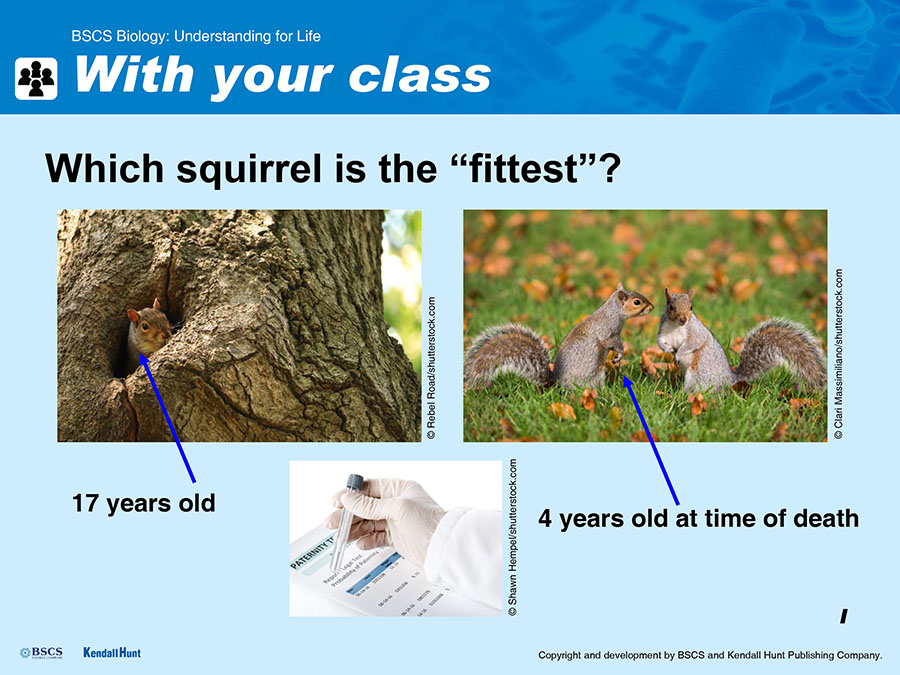
| Suggested prompt | Listen for student responses such as |
|---|---|
Which of these squirrels do you think would be the most “fit”? |
|
Common Student Ideas
A few common student ideas may still persist here, and that is to be expected—this discussion is designed to be an explicit opportunity to help draw them out and allow students to become more precise in their understanding of natural selection.
In particular, students may voice the following ideas:
The “fittest” in “survival of the fittest” means “the most physically fit.” (Darwinian fitness refers to a measure of the total [or relative] reproductive output of an organism with a particular genotype. It does not refer to physical condition, strength, or stamina.)
Survival of individuals with a trait variant (regardless of reproduction) leads that trait variant to become more prevalent via natural selection. (Survival is only important evolutionarily insofar as it affects the number of offspring produced.)
Keep Slide I displayed. Tell students: “A wildlife biologist was using this local squirrel population for an unrelated study, but as a result collected squirrel DNA. The analysis shows that within this population of squirrels, 2 individuals were the offspring of squirrel 1, but 16 individuals were the offspring of squirrel 2.”
| Suggested prompts | Listen for student responses such as |
|---|---|
Does this change what you were thinking with regard to which squirrel is the most “fit”? |
To pass on traits you have to reproduce. |
Even if the traits of “scaredy squirrel” are beneficial for keeping him out of the talons of the hawk, will those traits get passed on to any offspring? |
Even if a trait is good for keeping you alive, it can’t be passed on and benefit others in the population if you never have offspring. |
Can a population change to have a high proportion of individuals with a trait if the organism with the trait doesn’t reproduce and pass it on? |
|
Students reflect on how their thinking has changed about antibiotic use.
Tell students: “We’ve done a lot of refining of our ideas! Let’s go all the way back to the start of this chapter and see what we were thinking then. Pull up the student answers from the survey we took in Lesson 11 (or the tallies you recorded on the alternate sheet) and ask them to reflect on the results and what they mean. After a moment, step through the survey and as a class decide on what answers would be correct, referring to our Class Consensus Model as needed.”
| Suggested prompts | Listen for student responses such as |
|---|---|
Question 1: Janine and Samantha What did we say at the start of this chapter? What do we think now? |
Answers about initial responses will vary. Now we think antibiotics will not help Samantha’s cold, so taking them would unnecessarily create the potential for an antibiotic-resistant population to develop. |
Question 2: Doctor with Davon What did we say at the start of this chapter? What do we think now? |
Answers about initial responses will vary. Now we think antibiotics will not help Davon’s cold, so taking them (and pressuring the doctor to prescribe them) would unnecessarily create the potential for an antibiotic-resistant population to develop. |
Question 3: Maria on the phone with her mother What did we say at the start of this chapter? What do we think now? |
Answers about initial responses will vary. Now we think Maria should not take someone’s leftover antibiotics—taking them when not needed, or not having enough to finish a proper treatment, can create the potential for an antibiotic-resistant population to develop. |
Question 4: Carson with his prescribed antibiotics What did we say at the start of this chapter? What do we think now? |
Answers about initial responses will vary. Now we think Carson should finish his antibiotics even though he feels better—not finishing treatment can create the potential for an antibiotic-resistant population to develop. |
Ask students to think about how they personally answered the questions before, and how they would answer them knowing what they’ve learned about how antibiotic resistance develops.
| Suggested prompts | Listen for student responses such as |
|---|---|
Did the results of our survey show that we would always use antibiotics in a way that would prevent antibiotic resistance from developing? |
Most of us did not have a good idea about when to take antibiotics and when not to take them. |
If not, why do you think we were not always using them correctly? |
We didn’t really know how they worked, so we were just answering based on what we thought because of what we’ve done before. |
Do you think these results would be similar if we gave the survey to a random sample of adults? |
Yes, I don’t think people really understand what antibiotics do or how they really work. |
Sometimes it’s hard to understand what you don’t know about something if you don’t even know what there is to know. Do you think that people might be less thoughtful about following guidelines if they don’t understand why they exist? |
|
What did we do in class that led to changing your mind about these answers? |
We learned a lot about how they work and how resistance develops but not everyone can take a class to learn that. |
What could we do to help combat this issue? |
We could stop doing things that lead to antibiotic resistance, and tell our friends and family about what we know now. |
Is this an important issue to think about? |
We want to help fix this problem because we don’t want this to happen to us or someone we know. |
 UNDERSTANDING FOR ACTION
UNDERSTANDING FOR ACTION
PURPOSE | To apply understanding to plan or carry out action toward a solution for a societal issue
Connect back to our societal issue.
Ask students: “How does what we know now help us explain this worrying issue we found out about back in Lesson 1—that difficult-to-treat bacterial infections are getting more common?”
Display Slide K. Ask students: “Have you ever gone to the doctor or nurse and been upset that they didn’t give you any medicine or treatment, even though you felt really sick? How do you think this might connect to the concern about antibiotic resistance?”
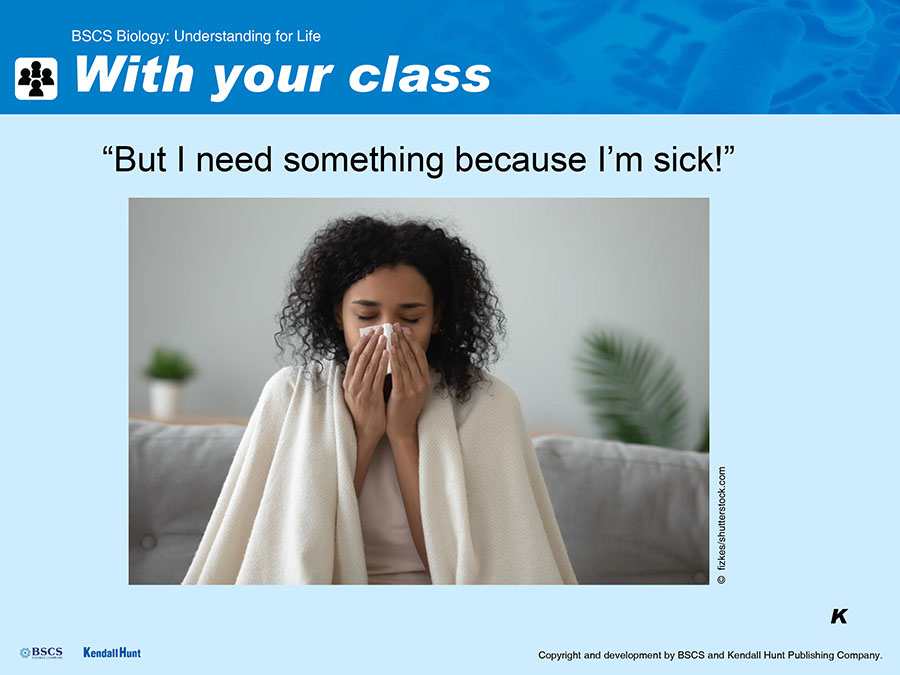
The class reorients to the Argument Tool.
Display Slide L. Tell students that this will be a chance to use what we’ve figured out and captured in our Class Consensus Model to support an explanation for how unnecessary use of antibiotics could contribute to the antibiotic-resistance problem.
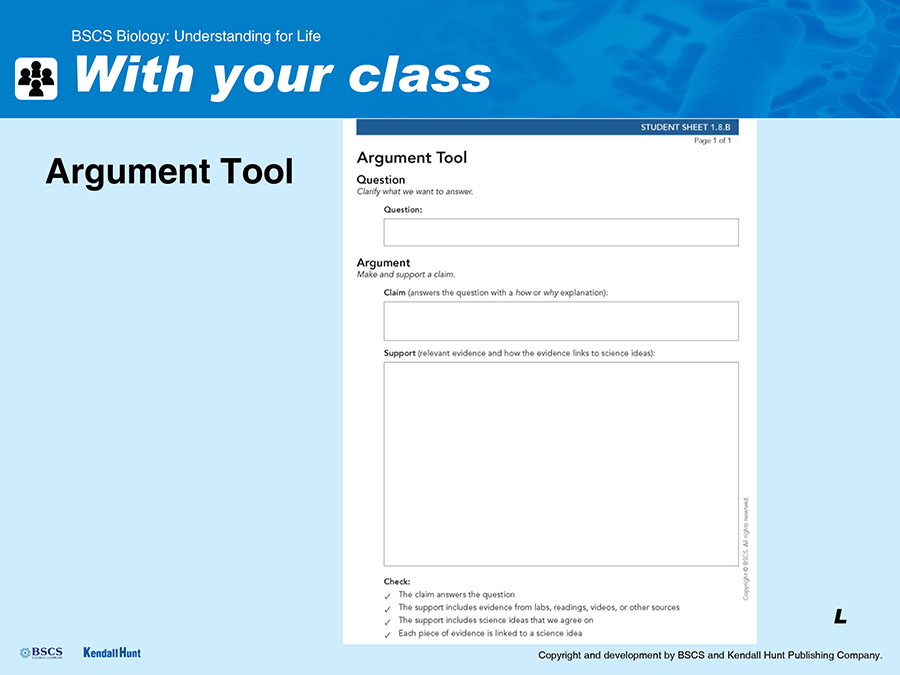
Hand out Student Sheet 1.15.A: “But I need something because I’m sick” to each student. Have them work independently to construct and support their explanation.
Question
Clarify what we want to answer.
Question:
How could unnecessary use of antibiotics contribute to the antibiotic-resistance problem?
Argument
Make and support a claim.
Claim (answers the question with a how or why explanation):
When we use antibiotics, we expose bacterial populations to a change in environment that makes resistant traits advantageous. Given that some populations have individuals with resistant traits, any time we use antibiotics, we give those individuals a chance to outcompete the others, leading to a large antibiotic-resistant population. Because of this we should only use antibiotics when we absolutely need to.
Support (relevant evidence and how the evidence links to science ideas):
When we look at a population of bacteria, it is made up of individuals that are not all exactly the same. Data from Lesson 12 showed that antibiotics alone do not usualy kill each individual bacterium. When we used the card simulation in Lesson 13 we saw that in addition to luck, bacteria could have certain traits that prevented the antibiotic from harming them, and they were more likely to survive even when the person took antibiotics. In Lesson 14 we used another simulation to see what would happen over time when bacteria with resistant traits were more likely to survive than susceptible bacteria in an environment where they are exposed to antibiotics. The simulation showed that over time more and more of the overall population would be resistant. If they hadn’t been exposed to antibiotics, bacteria with each trait would be equally likely to survive, so there would be no reason for there to be more and more resistant ones. This means that every time we use antibiotics, we risk developing a resistant population.
Sample completed Argument Tool.
Developing the Practices: Engaging in Argument from Evidence
Students independently construct an explanation for how unnecessary use of antibiotics could contribute to the antibiotic-resistance problem.
Developing the Practices: Constructing Explanations
Students support their explanation with evidence and science ideas using the Argument Tool.
Developing the Crosscutting Concepts: Cause and Effect
Students use the idea of smaller scale mechanisms (differential survival and reproduction of individual bacteria) to explain larger scale changes (a population that once had very few resistant individuals over time changing to be made up of mostly resistant individuals).
Formative Assessment Opportunity
Students’ completed Argument Tools are a good opportunity for formative assessment. To assess content understanding, look for student writing that includes the following key ideas:
Populations of bacteria are made up of individuals with variation.
Some of those variations are heritable.
Some of those variations confer protection in the presence of antibiotics.
As they are exposed to antibiotics, more individuals with helpful variations survive.
As these individuals reproduce and the ones that do not survive do not reproduce, the proportion of the population having the helpful (resistant) trait increases over time.
The more we use antibiotics, the more chances there are for populations to become resistant.
Look for student writing that:
Integrates evidence with science ideas, rather than treating them as separate lists
Only includes relevant evidence, not lists of everything we did in class
Communicates clearly to others, rather than assuming “mind reading” (e.g., “my evidence is that thing we did on Tuesday”)
Introduce the concept of antibiotic stewardship.
Display Slide M. Give students a minute to quietly read the definition. Ask students: Have you heard the word “stewardship” before? Some may have heard it in an environmental context; share that it means protecting, preserving, or taking care of something. Name that by being careful about when we use antibiotics, as they just explained in their Argument Tools, we engage in antibiotic stewardship. Work with the class to add this term to the Word Wall, and encourage students to add it to their personal glossaries as well.
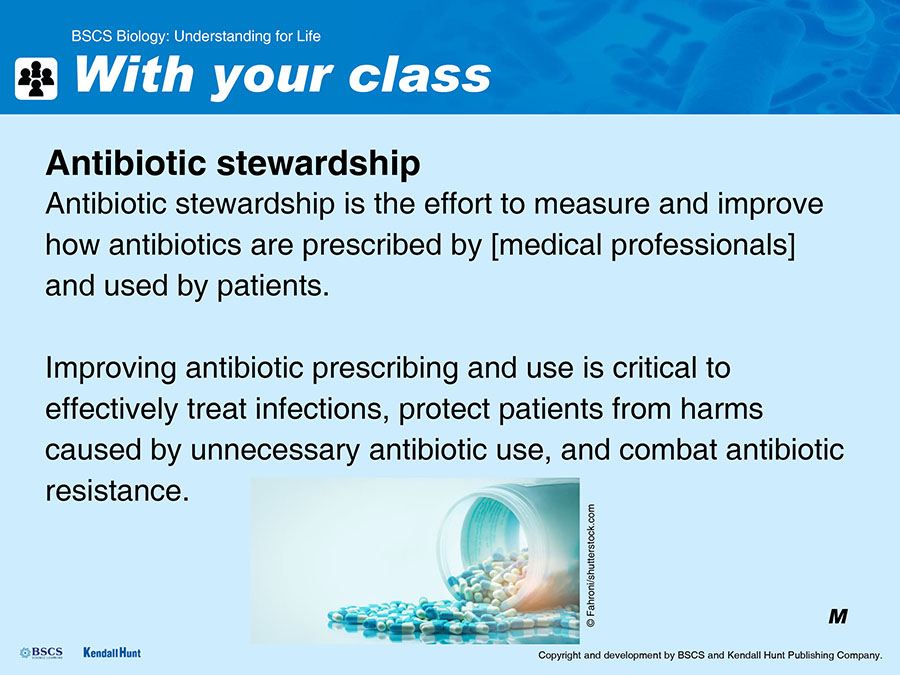
Expand thinking about actions we can take to promote antibiotic stewardship.
Tell students that in addition to being careful about overuse with patients, there are other aspects of the system that could be addressed to help with this problem. Hand out Student Sheet 1.15.B: Priorities for Action to each student. Display Slide N. Have students recall how we used these lenses to analyze solutions in chapter 2, and revoice some of the things to be looking for when applying each lens.
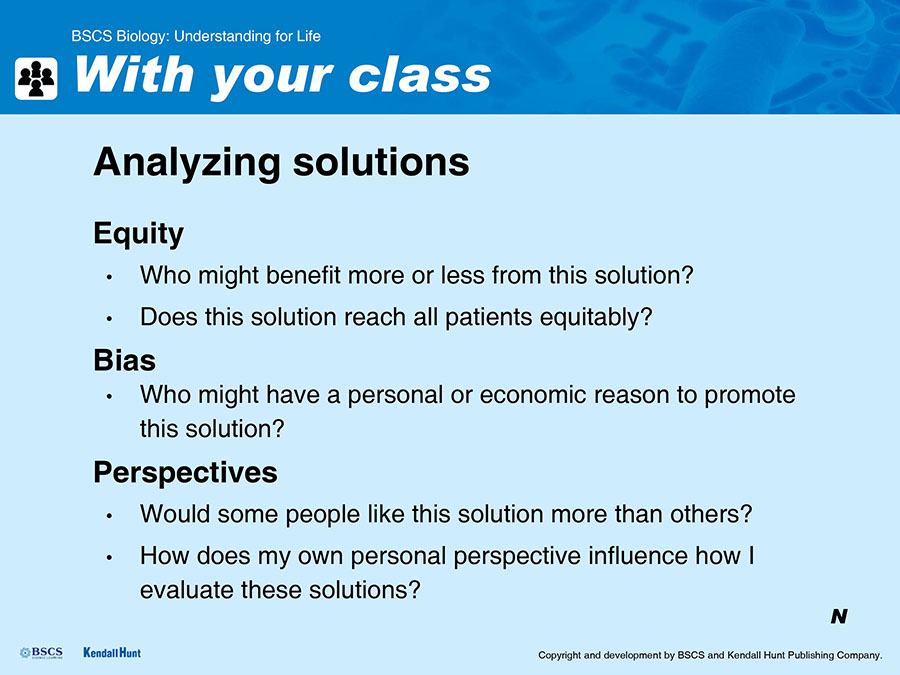
Student pairs read about three priorities for action toward antibiotic stewardship and analyze them with one of the lenses.
Organize students into pairs and assign each pair one of the three lenses (equity, bias, or perspectives) to work on. Give students time to read through the potential solutions and then discuss as a pair. After discussing, they should write down their ideas on their own student sheet and be prepared to share with the class.
Attending to Equity
Student conversations may surface inequities in their own lives; make it clear that they only need to share as they are comfortable with peers and the class. At the same time, establish that one of the reasons we consider equity as a lens when analyzing solutions to problems is because of known inequities in medical systems as well as food systems. By identifying potential for inequity in proposed solutions we can see how these problems start, but also how being proactive about applying this lens—especially in combination with including multiple perspectives—could lead to better outcomes in the future.
Students discuss their analysis as a class to share ideas across lenses.
Facilitate a class discussion about what students came up with in their analysis.
| Suggested prompts | Listen for student responses such as |
|---|---|
For those who considered equity, what did you discuss? |
|
For those who considered bias, what did you discuss? |
Drug companies may want the government to pay them to do research and development instead of using the other solutions, because they would benefit. |
For those who consider perspectives, what did you discuss? |
Some medical professionals who see patients may prefer to solve the problem by addressing use in food and the market, so they don’t have “be stingy” about prescribing medications “just in case” a patient needs them. |
 NAVIGATE
NAVIGATE
PURPOSE | To maintain coherence and continuity
Students discuss whether we are ready to make a decision about the best course of action.
Display Slide O. Give students a minute to silently read the quote from Dr. Spellberg again, which they first saw in Lesson 1. Facilitate a discussion about how we might want to take action.
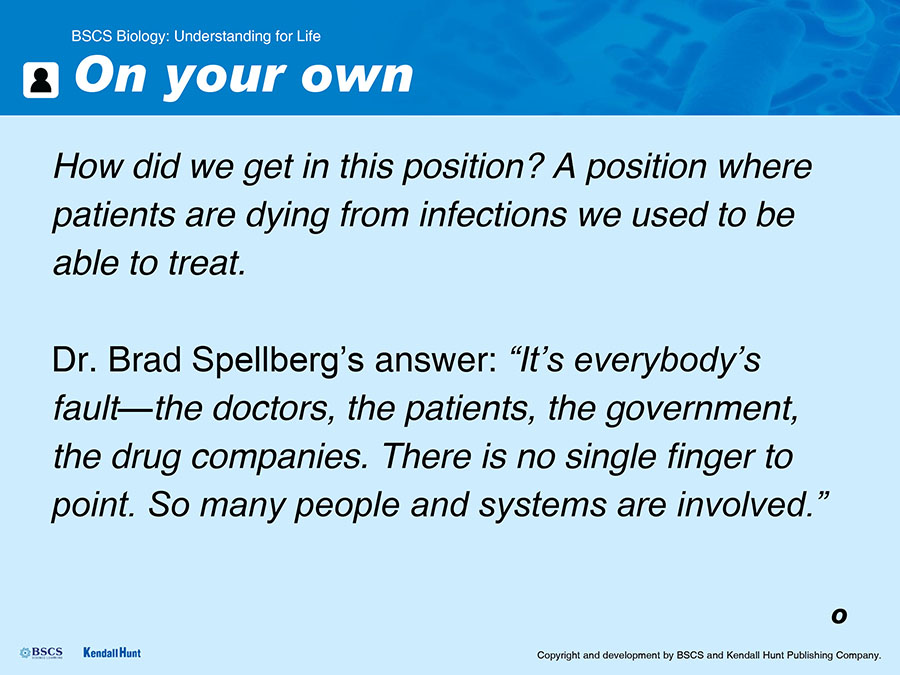
| Suggested prompts | Listen for student responses such as |
|---|---|
Given all of these stakeholders (doctors, patients, researchers, drug companies, governments), where do we fit in? |
|
Where could we start, if we want to help contribute to antibiotic stewardship? |
We could be better informed as patients and help other people in our lives do the same. |
Students celebrate their progress on the DQB.
Have students gather around the DQB to close it out. Celebrate how many questions we were able to answer and how that helped us ultimately figure out our big question: How can bacterial infections make us so sick, and why are they getting harder to treat?
Motivate students to engage in the Unit Assessment.
Tell students that they should now be well prepared to take a Unit Assessment, which will require them to apply their ideas to another societal issue—the use of pesticides in agriculture.
Motivate the need to put our learning into action in the Culminating Task.
Tell students that along with the Unit Assessment, they will have a chance to put their learning to practical use in a Culminating Task focused on taking action to promote antibiotic stewardship.
REFERENCE
Centers for Disease Control and Prevention. “Core Elements of Antibiotic Stewardship.” https://www.cdc.gov/antibiotic-use/core-elements/index.html#:~:text=Antibiotic%20stewardship%20is%20the%20effort,use%2C%20and%20
combat%20antibiotic%20resistance. (Slide M.)







